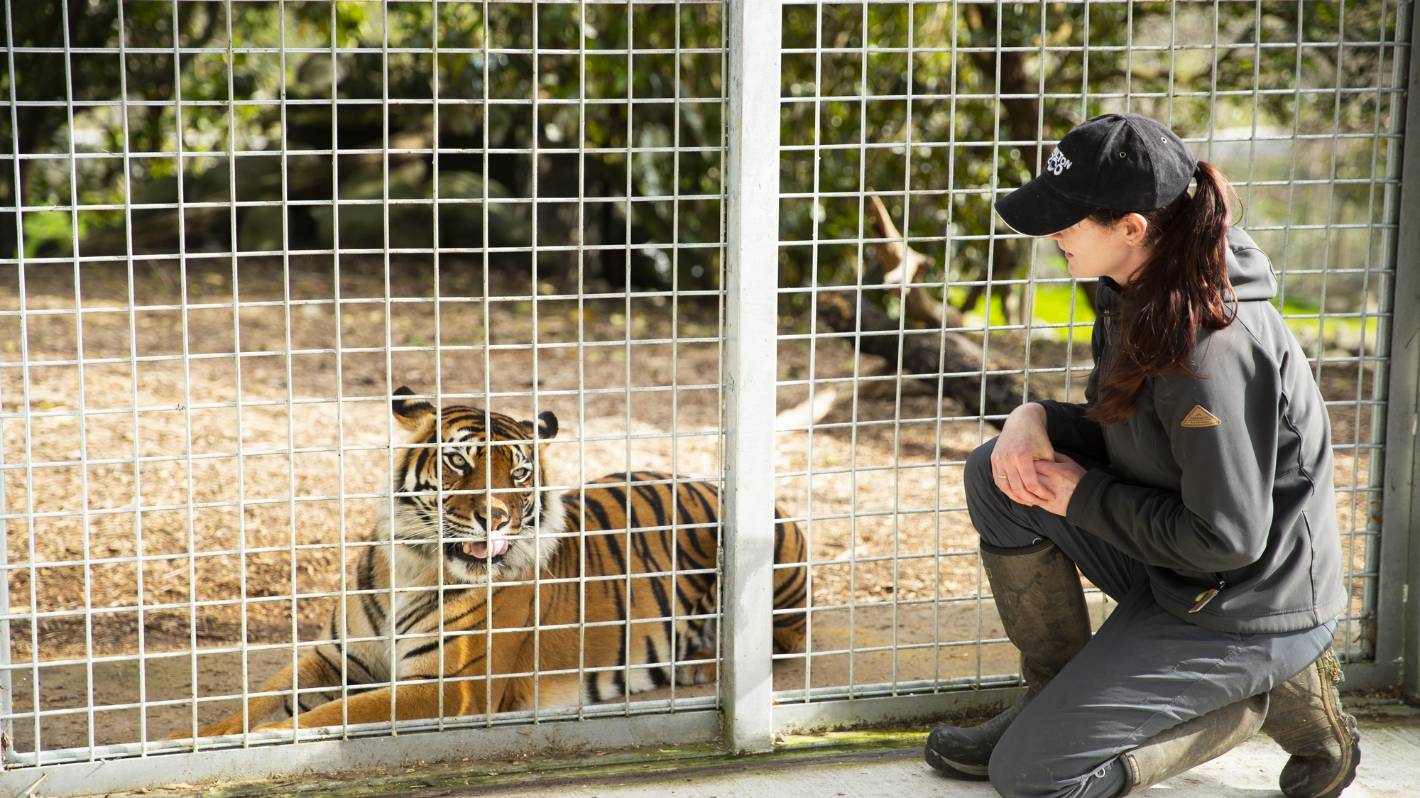Lions, tigers and chimpanzees would be first to be killed if a natural disaster was ever to cause a mass escape, zoos across Aotearoa have revealed.
Dr Baird Fleming, director of Hamilton Zoo, said such an escape would be an “exceptionally unlikely scenario” – usually, in a situation where animals were nervous or scared, they would stay within the area that felt like home.
However, the zoo’s animal containment team would assess the risks to humans in real time and the safety of humans would be prioritised, especially with dangerous animals, Fleming said.
There were two “category one” animals at the zoo, which were defined as able to cause human fatalities and might need to be shot.
READ MORE:
* Auckland Zoo to welcome back tigers this summer after two-year absence
* Jaguar attacks woman trying to take a selfie at zoo in the United States
* Zion’s big cat pride set for a public revival
At Hamilton Zoo that included only two species – chimpanzees and Sumatran tigers.
Fleming said all the structures at the zoo, along with staff training, procedures and plans, were designed to prioritise animal wellbeing and human safety.
Kamo Wildlife Sanctuary, on the outskirts of Whangārei, is home to two tigers, a leopard and 13 lions.
If any were to escape or if someone got into their enclosures and there was a direct threat to human life, the cats would have to be destroyed as per legislation, facility operator Janette Vallance said.
Christel Yardley/Stuff
Sali the tiger used to live at Hamilton Zoo but has now been moved to Auckland Zoo. (File photo)
Each enclosure had a 4-metre-high fence, with 1m inlay which ran into the enclosure, she said. All had electric wires, either powered by solar power or electricity and a back-up generator.
Each also had a secondary enclosure fence, designed to keep both people out and the cats in, and the ground also had a full-height perimeter fence.
Vallance thought the only thing that could bring down all the fencing was a large earthquake and Northland was at low risk for those.
Denise Piper/Stuff
Kamo Wildlife Sanctuary has a large boundary fence around its entire perimeter, as well as two enclosure fences.
“A number of the big cats, including the pride of three lions, are trained in emergency recall, where they will return to their den at a certain sound.
“Most of the big cats are very food orientated and it is possible they wouldn’t even leave their enclosure, because it is where they feel safe.”
The most dangerous animal at the wildlife sanctuary was the black leopard Mandla, Vallance said, because of his speed.
“The sanctuary would not be able to use tranquillisers on our cats in an emergency, as they have to be dispensed by a vet and take too long to work.”
Rob Pine/Supplied
Black leopard Mandla was considered to be the most dangerous big cat at the park due to his speed.
Auckland Zoo director Kevin Buley agreed a mass escape was incredibly unlikely, but you should “never say never”.
“We’ve seen over in Ukraine at the moment, animals having to be relocated to other countries as zoos are now in the middle of war zones.
“I cannot imagine a scenario here where we would have a mass escape, but if we did it’d most likely be due to a volcano, earthquake or tsunami.”
Buley said the zoo did have a plan if anything like that happened and there was an emergency response team.
Some animals, if they escaped, would be considered a “red response”, Buley said. These animals – including the zoo’s top carnivores, lions and tigers – would have to be killed.
“We work with the armed offenders squad on how to safely deploy firearms. The general approach is safety first and preserve human life.
“We can’t use tranquillisers on these red response animals as they don’t work immediately to stop the threat.”
The zoo also practised what would happen if a person somehow fell into an enclosure or purposefully got inside.
AUCKLAND ZOO/Supplied
The escape of lions or tigers at Auckland Zoo would be considered a “red response”.
Lions and tigers were the only animals that would have to be killed in such an event, Buley said, as all other species had the potential to be returned to their habitats safely.
Orana Wildlife Park in Christchurch was also contacted for comment but declined to talk about its emergency procedures.
However, in 2013, it was reported Orana Park had a containment manual for each of the 70-plus species in its care.
There were risk profiles of each animal and how best to recapture them if they happened to escape from their respective enclosures.
High-profile escapes
In 1986, three lions escaped from Whirling Brothers circus and spent a couple of hours prowling the Rotorua waterfront.
Armed police responded, but the lions were safely returned to their cages without injuring any members of the public. The ringmaster’s wife’s poodle Lucy, however, was mauled to death.
In 2010, three cheetahs escaped from their enclosure at Orana Park and roamed the public area for 30 minutes. Chief executive Lynn Anderson said the “serious incident” triggered the park’s emergency lockdown procedures.
All visitors were taken to safe places and keepers were sent to catch the animals, along with a veterinarian with a tranquilliser gun, but the cheetahs were able to be herded into their enclosure without incident, she said at the time.
RYAN ANDERSON/Stuff
Burma the elephant escaped Auckland Zoo in 2004 and spent about 25 minutes in the adjacent Western Springs Park.
In 2009, pygmy marmoset Machu wriggled out through a crack in his enclosure at Wellington Zoo, but did not go far and was recaptured just metres away.
Primate zookeeper Vimal Patel said he “freaked out and stayed put” when he realised his female friend Picchu was not with him.
An otter named Jin captured Kiwis’ imaginations after escaping Auckland Zoo in 2006 and spending 26 days on the run. She dug through two walls and scaled a 1.8 metre-high barrier to reach freedom.
Two years prior, Auckland Zoo’s elephant Burma dropped a large log onto an electric fence and escaped into Western Springs Park. She was recaptured about 25 minutes later and walked back to her enclosure by staff.




